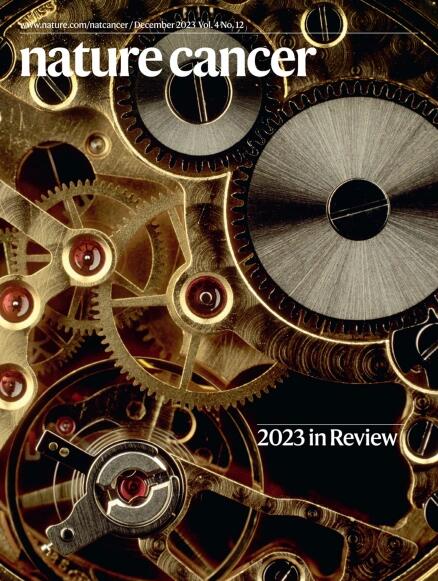TIGIT 和 PD-L1 联合阻断可通过促进联合刺激,促进多能、非衰竭抗肿瘤 T 细胞的克隆扩增。
IF 23.5
1区 医学
Q1 ONCOLOGY
引用次数: 0
摘要
阻断免疫检查点PD-1和TIGIT在小鼠肿瘤模型和人类癌症患者中显示出活性。尽管这些共抑制受体可以通过调节其相关的共刺激受体CD28和CD226来限制CD8+ T细胞的信号传导,但PD-1和TIGIT联合阻断的功能后果仍然缺乏表征。在小鼠肿瘤模型中,我们发现联合阻断诱导了cd226驱动的肿瘤抗原特异性CD8+ T细胞克隆扩增。扩增的克隆从引流淋巴结中的干细胞样细胞群体中出现,作为先前未识别的单表型多克隆群体进入血液。到达肿瘤后,这些过境细胞进一步扩增并分化为效应T细胞或耗竭T细胞,联合阻断有利于共刺激,限制了进入耗竭途径。因此,PD-1和TIGIT抑制有助于形成引流淋巴结中肿瘤反应性CD8+ T细胞的库,并决定其在肿瘤中的免疫命运,以提高治疗效果。对临床试验样本的分析表明,类似的机制也可能发生在癌症患者身上。本文章由计算机程序翻译,如有差异,请以英文原文为准。

TIGIT and PD-L1 co-blockade promotes clonal expansion of multipotent, non-exhausted antitumor T cells by facilitating co-stimulation
Blockade of immune checkpoints PD-1 and TIGIT has demonstrated activity in mouse tumor models and human patients with cancer. Although these coinhibitory receptors can restrict signaling in CD8+ T cells by regulating their associated co-stimulatory receptors CD28 and CD226, the functional consequences of combining PD-1 and TIGIT blockade remain poorly characterized. In mouse tumor models, we show that combination blockade elicited CD226-driven clonal expansion of tumor antigen-specific CD8+ T cells. The expanded clones emerged from a population of stem-like cells in draining lymph nodes, entering the blood as a previously unidentified single-phenotype, multiclonal population. Upon reaching the tumor, these transiting cells expanded further and differentiated into effector or exhausted T cells, with combination blockade restricting entry into the exhaustion pathway by favoring co-stimulation. Thus, PD-1 and TIGIT inhibition helps shape the repertoire of tumor-reactive CD8+ T cells in draining lymph nodes and determines their immunological fate in the tumor to enhance therapeutic benefit. Analysis of clinical trial samples suggests a similar mechanism may also occur in patients with cancer. Mellman and colleagues present a multiomic single-cell analysis of the effects of combined anti-TIGIT and anti-PD-1 blockade on T cell populations trafficking from the draining lymph node to the blood and tumor.
求助全文
通过发布文献求助,成功后即可免费获取论文全文。
去求助
来源期刊

Nature cancer
Medicine-Oncology
CiteScore
31.10
自引率
1.80%
发文量
129
期刊介绍:
Cancer is a devastating disease responsible for millions of deaths worldwide. However, many of these deaths could be prevented with improved prevention and treatment strategies. To achieve this, it is crucial to focus on accurate diagnosis, effective treatment methods, and understanding the socioeconomic factors that influence cancer rates.
Nature Cancer aims to serve as a unique platform for sharing the latest advancements in cancer research across various scientific fields, encompassing life sciences, physical sciences, applied sciences, and social sciences. The journal is particularly interested in fundamental research that enhances our understanding of tumor development and progression, as well as research that translates this knowledge into clinical applications through innovative diagnostic and therapeutic approaches. Additionally, Nature Cancer welcomes clinical studies that inform cancer diagnosis, treatment, and prevention, along with contributions exploring the societal impact of cancer on a global scale.
In addition to publishing original research, Nature Cancer will feature Comments, Reviews, News & Views, Features, and Correspondence that hold significant value for the diverse field of cancer research.
 求助内容:
求助内容: 应助结果提醒方式:
应助结果提醒方式:


